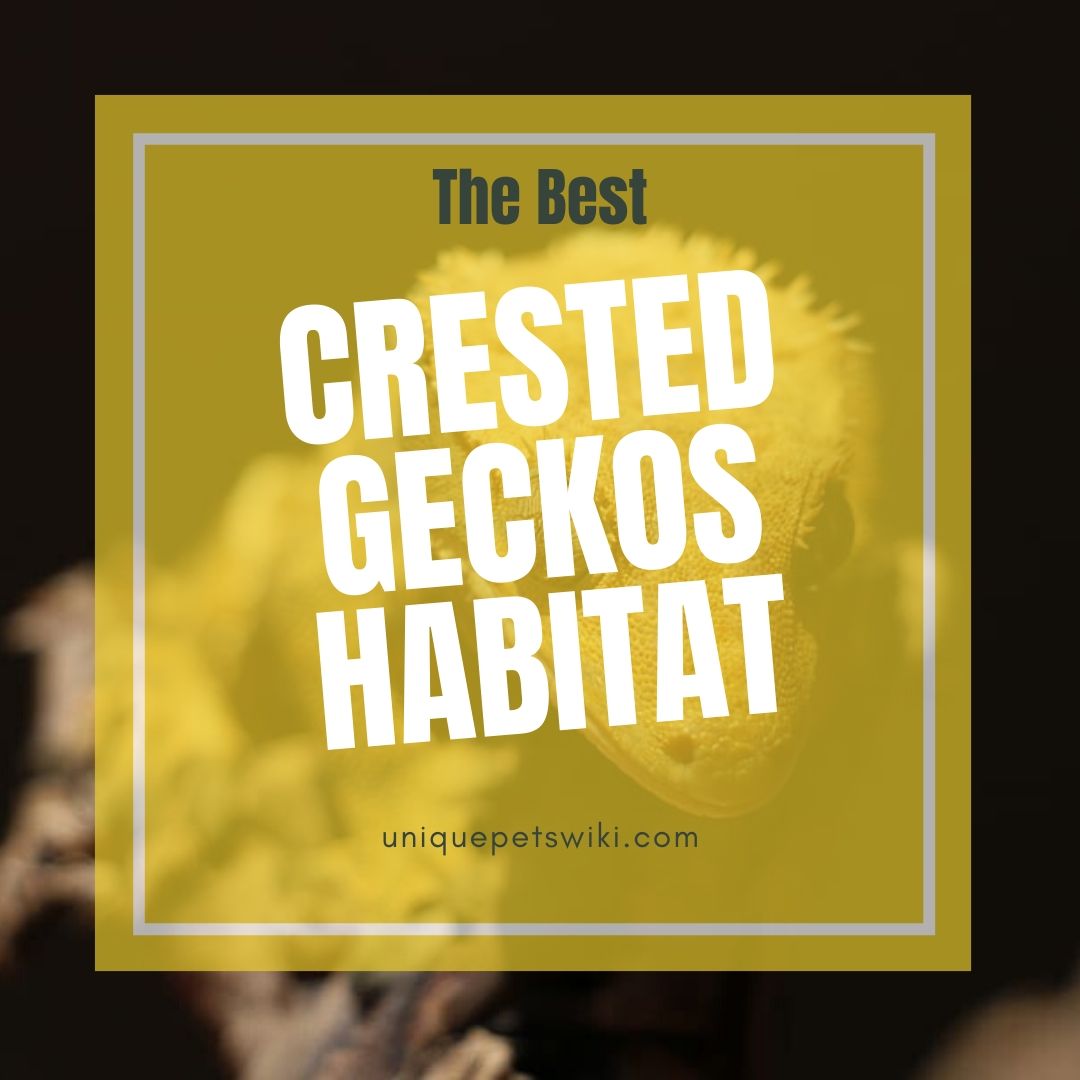Crested geckos are fascinating pets that you can get even for first-time reptile owners. One of the things that you will consider before you buy a crested gecko is its habitat. Setting up an enclosure for crested gecko is quite simple as it can stay in a small but high cage.
Cresties are semi-arboreal animals and will like it if there is enough space for them to jump and climb inside their tank. You will learn everything about setting up crested gecko habitat and the accessories you can incorporate in the tank in this post.
Contents
- The Best Crested Gecko Habitat Setup at a Glance
- Enclosure (Tanks)
- What Enclosure to Choose for a Crested Gecko?
- Recommended Crested Gecko Tank Size
- Substrate (Flooring)
- Landscaping and ‘Furniture’ Needs (Branches, Rocks, etc.)
- Temperature
- Secondary Heat Source
- Light
- Water and Humidity
- Decorations
- Cage Location
- Bad Cage Locations
- Good Cage Locations
- Cleaning and Maintenance of Cage
- Conclusion
The Best Crested Gecko Habitat Setup at a Glance
Crested geckos originate from mild to warm, humid environments. Although you can provide a basking area for your gecko, it should be around 75oF as they can get stressed if warmer.
It is best if their tank is a tall glass enclosure with front and top ventilation to prevent overheating.
Crested geckos are semi-arboreal animals and will love to climb and stay off the floor. You will need to provide them with hardwood decorations fitted firmly to provide alternative routes for them to climb up and down the enclosure.
They are a nocturnal animal, and you will need to provide a humid hides where they can snooze during the day. Crested geckos usually get their water from dew on leaves and flowers, and you will need to provide either real or artificial leaves and plants in their enclosure.
Enclosure (Tanks)
There are different housing types available to crested geckos habitat. You need to know the types available to decide the one suitable for your home.
Types of Enclosures
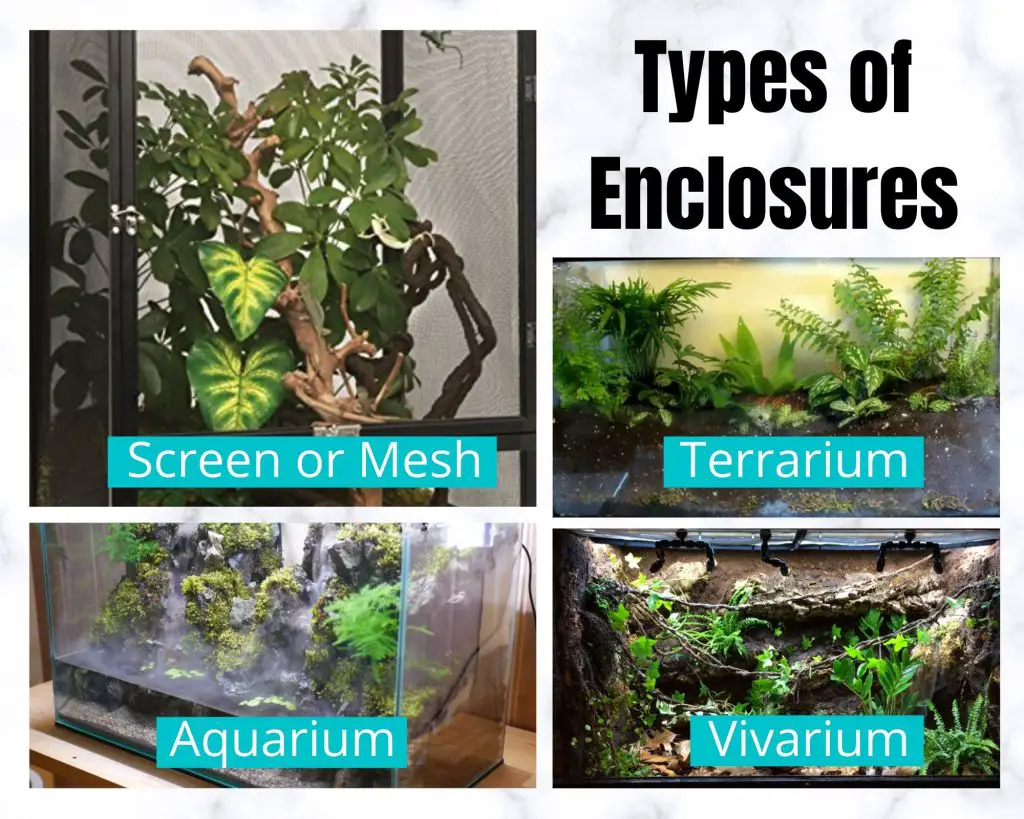
Some of the common enclosures suitable for crested geckos are
- Terrarium
- Vivarium
- Aquarium
- Screen or mesh cage
Terrarium
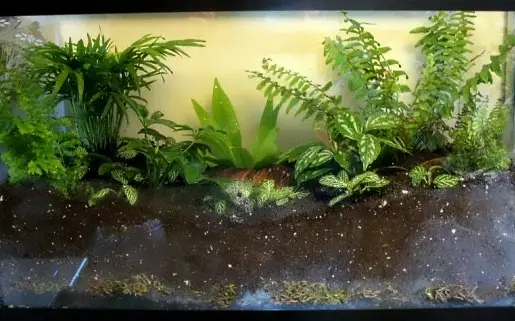
A terrarium is a glass enclosure that usually consists of only plants and soil. It typically has openings used for taking care of the plants. A terrarium is mostly used for decorative or ornamental function.
However, you will often hear it when you are looking for a tank to house your cresties.
People usually confuse the terms terrarium and vivarium together, and you will even see some sites use the term terrarium for a vivarium. However, this is fine after you know what the term terrarium entails.
Vivarium
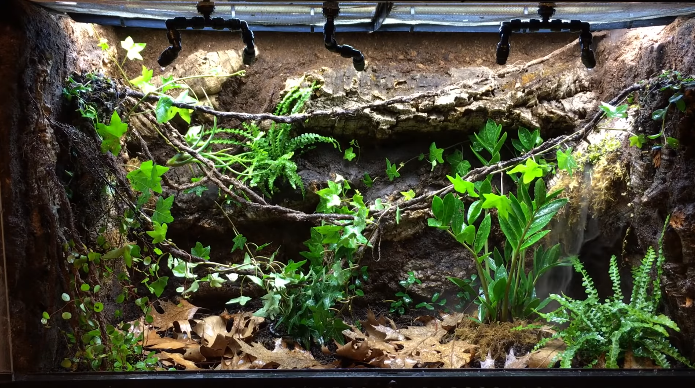
This is the correct term for a reptile enclosure. It is used for housing small animals such as reptiles and amphibians. You can use a vivarium to mimic crested gecko’s natural habitat by adding plants and branches in it.
A vivarium can be small or large based on your crested gecko size, the number of animals, and even your taste. Most pet owners use smaller vivariums that can be placed on a table or cabinet for crested geckos.
Aquarium
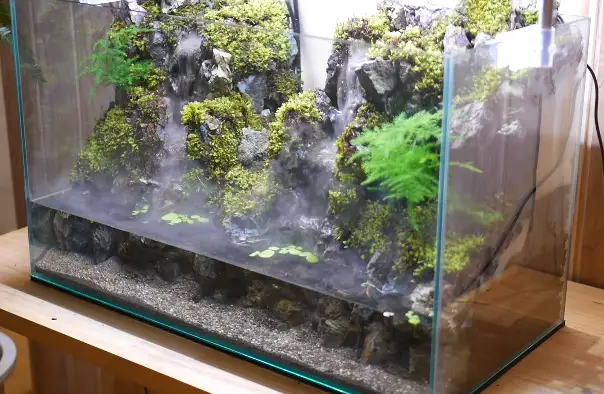
(Source: 植物男子 Asu YouTube)
This is another kind of enclosure that can be used to keep plants and small aquatic animals. An aquarium is different from a terrarium or a vivarium as it contains water, and it is mostly used to keep fish.
However, you can use it to house reptiles if you are a bit handy and make necessary adjustments.
Screen or Mesh Cage
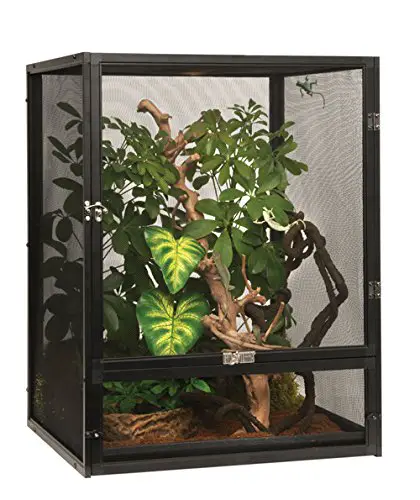
Although a mesh cage is often used for keeping rodents, you can use it to keep some reptiles like crested geckos. It usually comprises a frame that is made of aluminum or plastic. It then features a screen or mesh pulled over the frame and can be zipped on one or more sides.
The mesh can be made of nylon, fiberglass, or plastic, and it provides proper ventilation for easy misting of the enclosure.
What Enclosure to Choose for a Crested Gecko?
Each enclosure type has different advantages and disadvantages, and you can choose an enclosure that will best suit your situation. It is easy to keep the humidity at a decent level with a vivarium or aquarium.
It is also easy to clean, but there is a higher risk of overheating if placed under direct sunlight.
You can use a screen cage if you live in a dry or moderate climate. Screen cage has better humidity, but it is difficult to keep the humidity up.
Recommended Crested Gecko Tank Size
Although there are different views when it comes to the size of a crested gecko tank size. But you can keep hatchlings and juveniles around 10g in an enclosure between 1.5 and 5 gallons. You can keep juveniles from 10-25g in an enclosure between 7-10 gallons.
Adults that weigh over 25g can be kept in a 20 gallons tank while a 30 gallons tank for a pair of crested geckos.
You can keep hatchlings and juveniles crested geckos in a smaller enclosure. This is because they will find it hard to find food in a large cage. You will need to provide a small environment with few plants and do not even need elaborate climbing possibilities.
You can keep a single adult crested gecko in a 20-gallon or larger enclosure. However, some crested geckos can find a 20-gallon tank too large and may not be happy.
If you notice that your crested gecko starts losing weight, the tank size may be the reason. You will need to add 5 gallons to the minimum tank size if you want to house multiple crested geckos in a tank.
However, you can opt for the special crested gecko habitats made by popular brands. A small crested gecko habitat is usually 12x12x18 inches, while large crested gecko habitat is 18x18x24 inches in size.
New to crested gecko? Check out the crested gecko care sheet now! We had listed out all the things you need to know about crested gecko as pets. Check it now!
Substrate (Flooring)
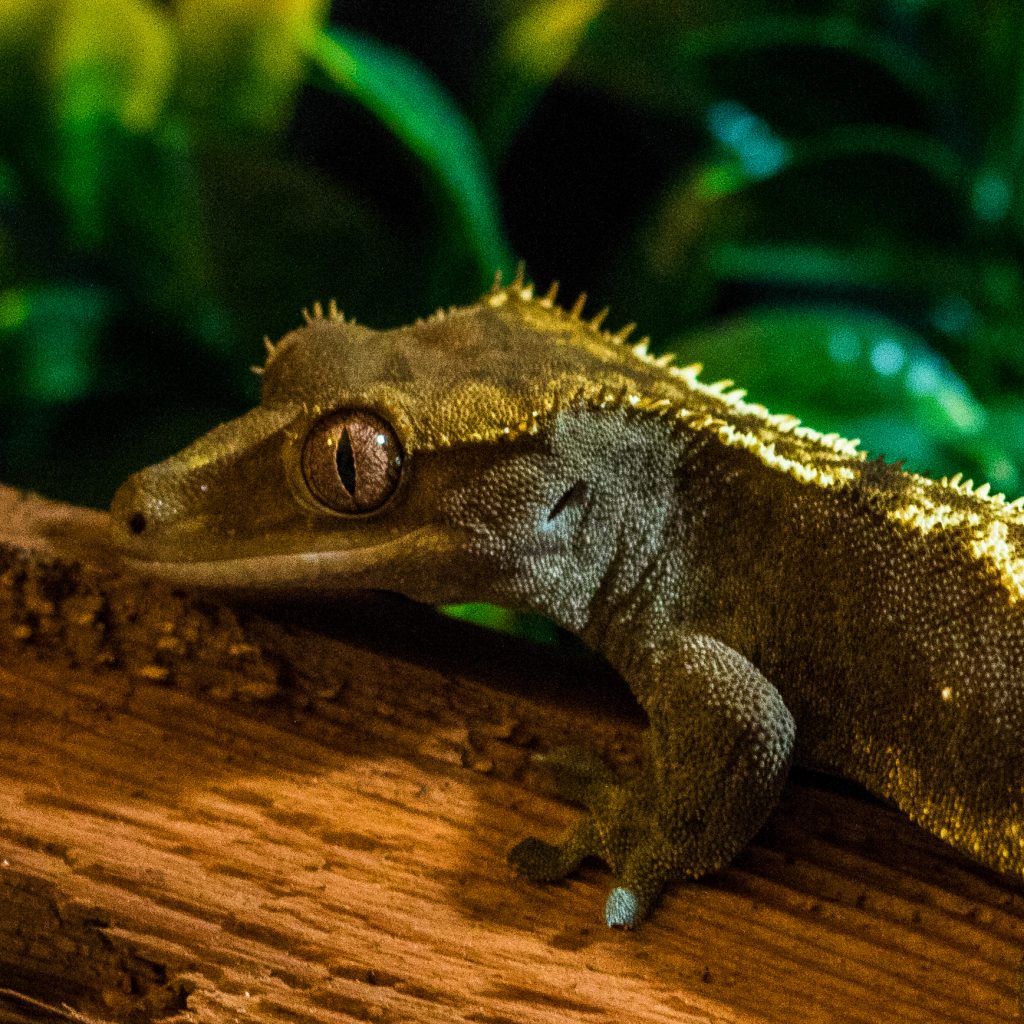
The term substrate can be compared to the flooring of our house. Substrate simply means the covering of the bottom of your crested gecko’s vivarium. It can also be called the bedding or bedding material.
Before you choose a substrate for your gecko, you will need to consider your pet safety, can it retain humidity and the ease of cleaning.
Substrate Types
There is a wide range of substrates, and it is not all of them suitable for all reptiles. There are some substrates suitable for a dry vivarium, while some are ideal for the humid vivarium. Some of the common substrate types are stated below.
- Newspaper
- Carpet
- Moss
- Mulch
- Wood shavings
- Soil
Newspaper

Newspapers are the oldest and cheapest substrates suitable for a vivarium. It is a perfect choice if you are on a budget. Newspapers are absorbent materials and will absorb your reptiles waste.
You do not even need to clean the Substrate but remove and replace it with new ones daily.
However, the major concern is that the printer’s ink used on the newspapers are toxic for reptiles. From a safety or toxicity point of view, you can use old newspapers as Substrate.
Carpet
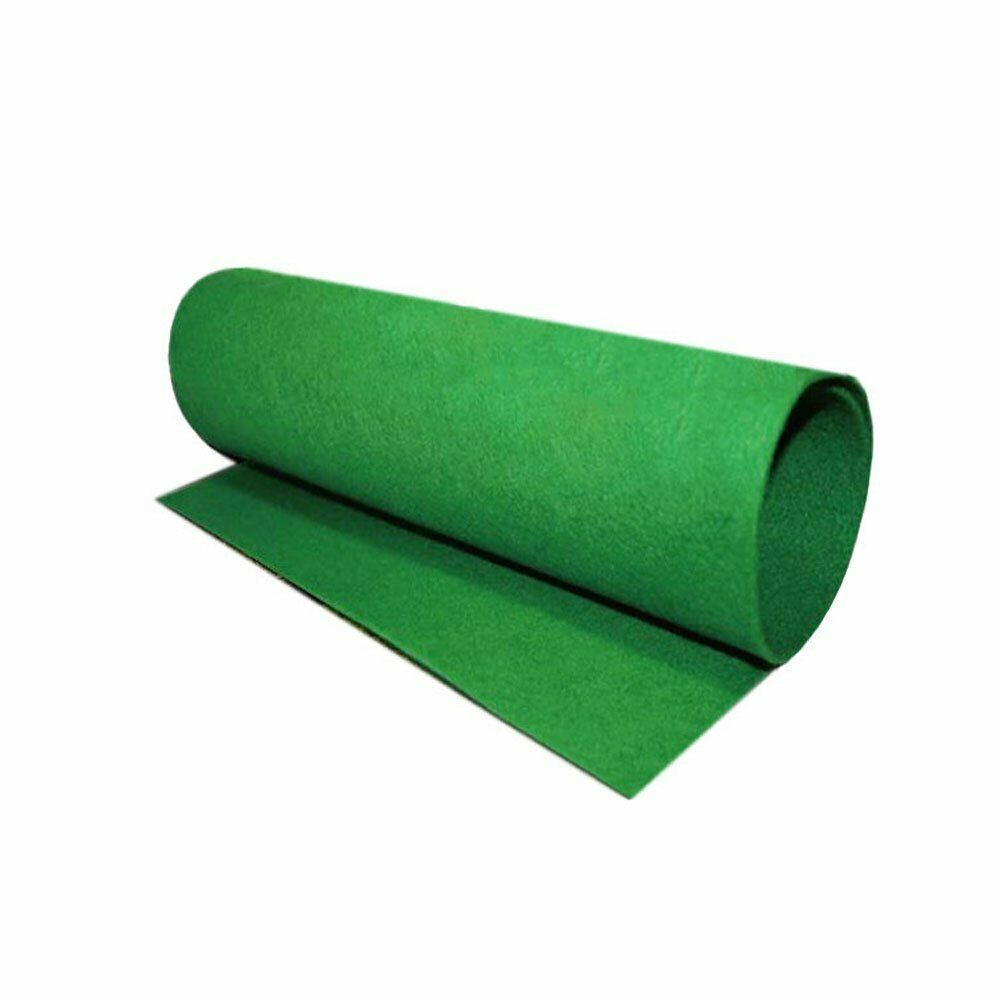
This is another cheap substrate option for your reptile vivarium. Carpets are soft, and you can treat it with a waterproof liner to prevent leakage from water and waste.
However, you will need to take out the carpet for cleaning regularly. You can buy at least two pieces of carpet, and you can interchange them while washing the dirty carpet.
You can also use the carpet as a base substrate with another substrate on top. However, if you use carpet as a base substrate for moist Substrate, it can cause fast bacterial growth in the carpet.
Moss
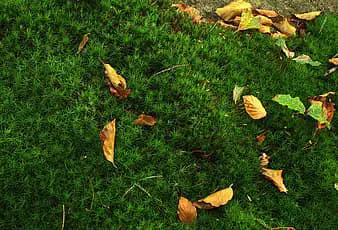
This is a perfect substrate for forest vivaria and smaller reptiles. You can get moss in your area or buy them from a store. Moss looks natural, and it is perfect for creating high humidity in your tank. It is soft, and it has a slow growth rate.
Sphagnum moss is the most common type of moss substrate out there. You can buy them in the form of small bales or flat sheets. Sphagnum moss helps to maintain a slightly acidic pH in the soil and will hold water very well.
However, it is expensive, and some users have noticed fungal infections when using it.
Coconut Bedding (Husk/Coir)
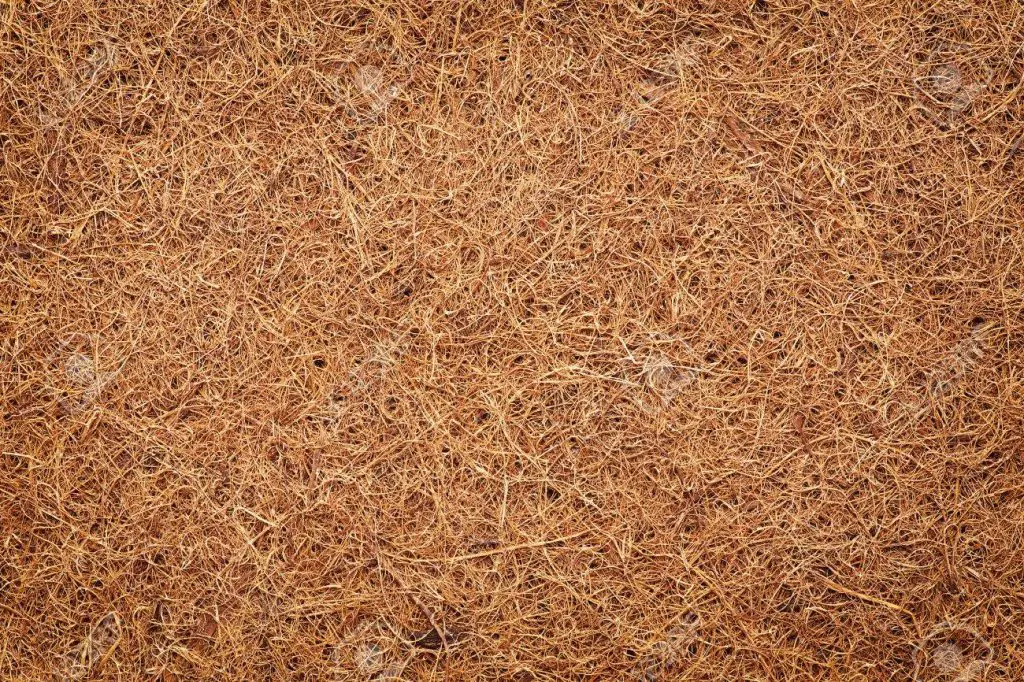
This is a special kind of Substrate made of coconuts. Coconut beddings used for reptiles are chopped and processed hairs of the coconut husk. The processed coconut shells are also used as a substrate at times.
Coconut bedding has proper absorption but is not as popular as other substrate types.
(Reprocessed) Paper

This is a popular bedding material used for pet rodents and reptiles. Although reprocessed papers have high absorbent properties, it is too expensive and will also break down easily.
However, you can use all kinds of papers like paper towels or old newspapers for your gecko. You will even find commercial paper cage liners that you can use for your crested geckos.
Mulch
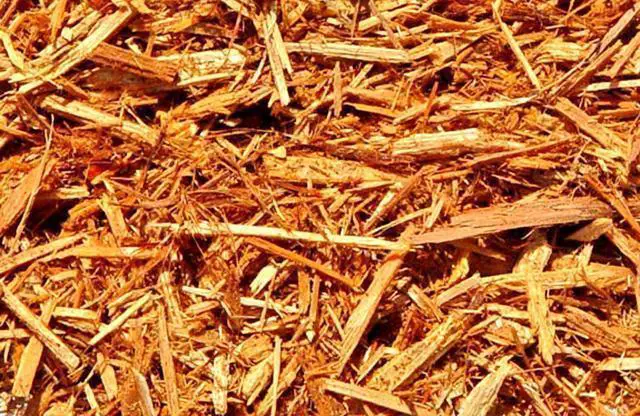
Mulch is among the popular substrates that you can use for your reptiles. The best thing is that they are of uniform size and will create a natural-looking vivarium for your geckos. It is also biodegradable, and you can use it in your garden after use in the tank.
It has a high absorption rate and will help retail lots of waste before you change it. However, mulch contains sharp pieces that can harm your gecko. It is hard to clean mulch, and you will need to replace mulch after use.
Wood Shavings
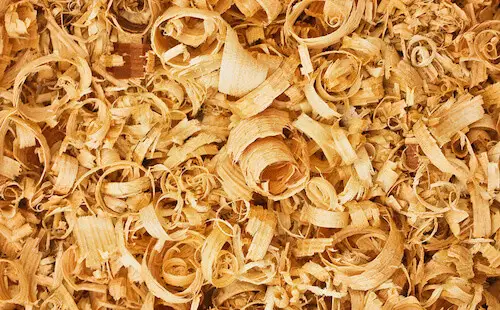
Other popular substrates used for reptiles are pine and aspen wood shavings. They are heat-treated to remove the toxic oils in them. However, aspen shavings are better than pine shavings.
Aspen has a more uniform shape and is dust and toxic chemicals free. But it is more expensive than pine shaving.
You can also use wood shavings as cheap to replace when you want to clean the cage. It also looks natural and will absorb water and waste very well.
You should avoid using cedar shavings because they consist of volatile oils and have a distinctive smell. The smell can lead to kidney and respiratory problems if used in a closed environment like the vivarium.
Soil
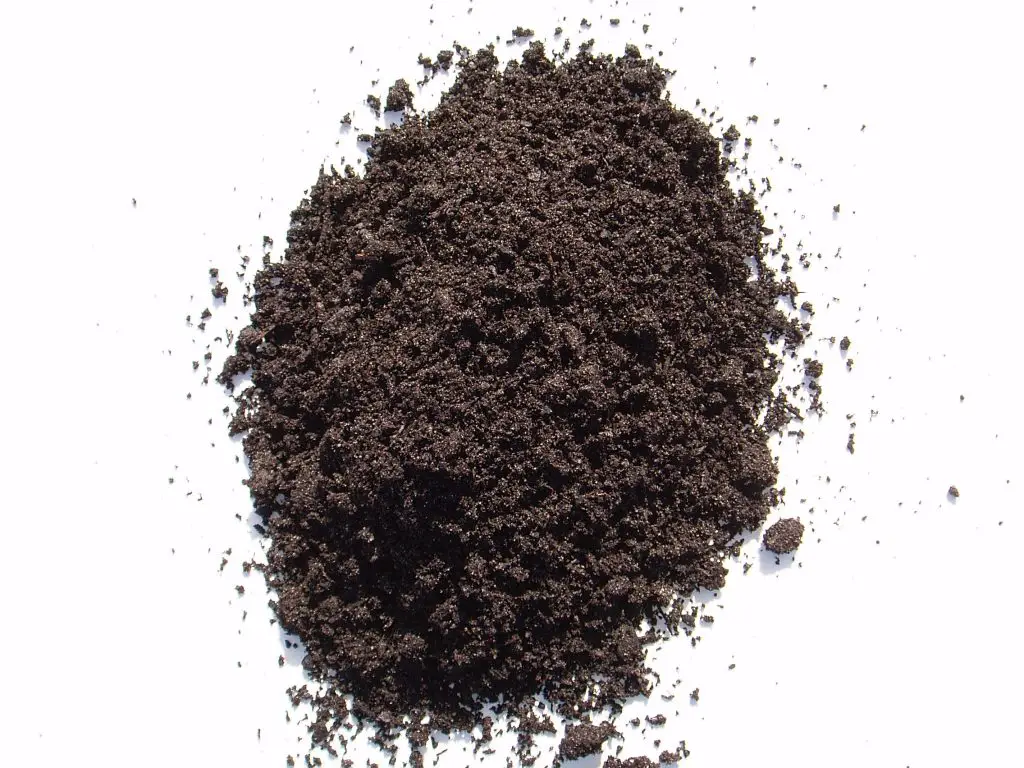
This is among the best and most used substrates for crested geckos. You can easily use the soil in your backyard or get organic soil from the store.
New to crested gecko? Check out the crested gecko care sheet now! We had listed out all the things you need to know about crested gecko as pets. Check it now!
However, when getting a soil for your reptile substrate, try to avoid products with perlite, vermiculite, herbicides, manure, and fertilizers.
Vermiculite and perlite can lead to impaction if ingested by your crested gecko. Herbicides, fertilizers, and manure contain toxic chemicals that can kill your gecko.
Bark
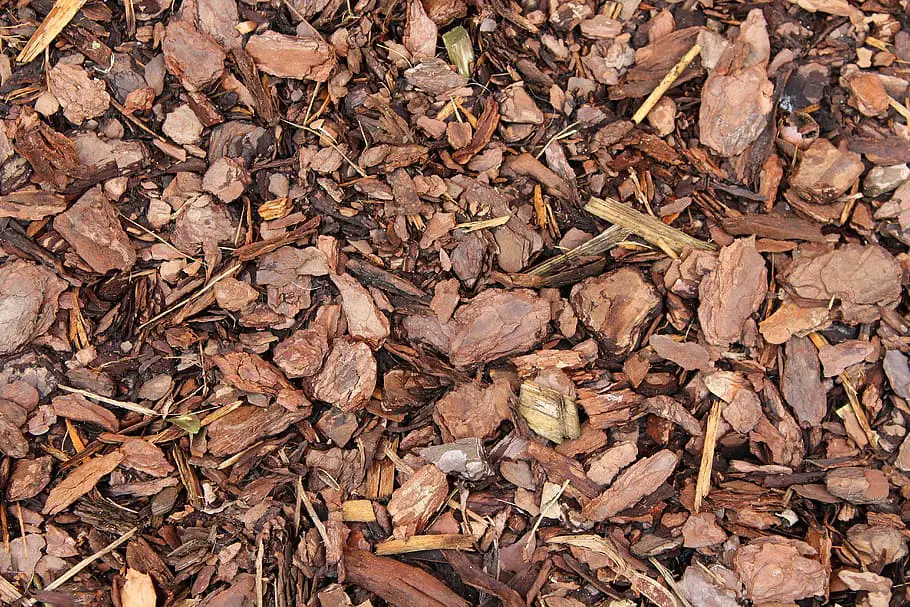
This is a budget-friendly substrate used in terrariums. It helps to create a natural look, and it can absorb water in high humidity terrariums. You can use the bark of the fir tree, also known as orchid bark.
It is very easy to clean fir bark, but you will have to replace it after a month.
Landscaping and ‘Furniture’ Needs (Branches, Rocks, etc.)
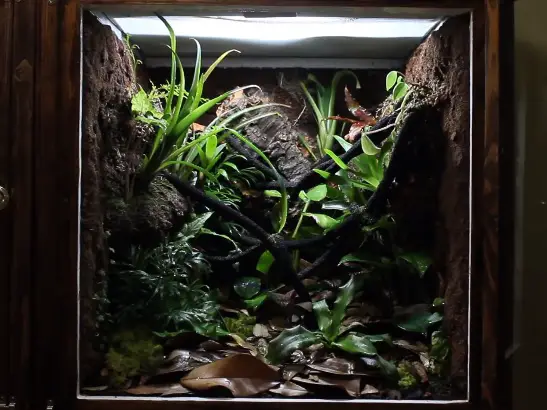
You should make sure that the substrate you use for crested geckos can promote humidity and it is easy to clean. Some of the best substrates that you can use are cypress mulch, orchid bark, coco bedding, patches of sphagnum moss, or a combination.
Since crested geckos are arboreal animals, you will need to provide different climbing structures within their tank. If you plan to use plants, it is best to use plants with broad and flat leaves.
Your crested gecko can use it as their resting spot.
You may use driftwood, cork bark tubes, cork bark flats, and both live and artificial plants in your tank. Crested geckos love jumping from one branch to another within their enclosure and hanging from slabs of cork bark.
It is recommended to use cork flats and cork rounds with one or two ficus trees in your gecko’s enclosure.
Temperature
Crested geckos are cold-blooded animals, and you will need to regulate their body temperature. The daytime temperature of your tank should be around 72 to 80oF. And night temperature should be between 65 to 75oF.
You will need to monitor your crested gecko’s tank with a thermometer to ensure that it does not overheat. This is because cresties get stressed at higher temperatures.
Secondary Heat Source
You will need to provide your gecko with a warm basking area of 75oF. You can achieve this by attaching a heat mat to the outside of the glass panels. You can control the temperature with a thermostat and keep it on both day and night to keep the tank warm.
However, if the room that you keep the tank is extremely cold, you can use a low wattage bulb as the heat source. This will give you the chance to watch your geckos at night as well.
However, avoid placing a heat source on the top of the tank as your geckos can climb too close and get burned.
Light
In the wild, crested geckos will stay in partial shades. However, you can use UVB lighting as an optional extra in their tank. If your crested gecko terrarium has a mesh lid, it will reduce UVB light strength into the tank.
It is best to use a wide covering of 5% UVB or smaller covering of 6-7% UVB.
There are several lamps that you can choose from, and it is best if you mount it above the terrarium towards the front or back of your crested gecko’s tank.
This will help to give a gentle UV gradient from the back of your cresties tank to the front. This will fit your gecko’s requirement, and they will easily find a perfect spot to stay.
Water and Humidity
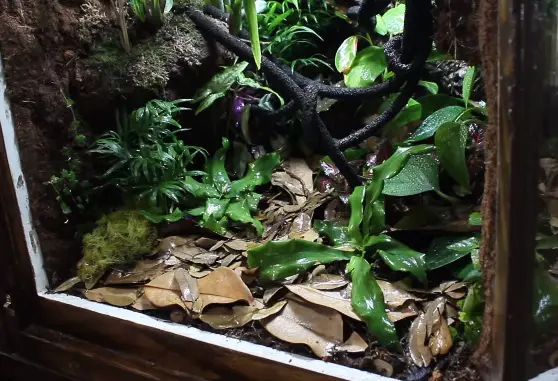
(Source: SerpaDesign YouTube)
Your crested gecko needs a moderate to the high humidity level in their tank. It is best if you aim for a 60% humidity level during the day and 80% humidity level at night. You can easily monitor the humidity levels daily with a hygrometer.
Some of the ways to provide humidity in your crested gecko’s tank are by regular misting with warm and filtered water. You will need to mist your tank a few times a day based on your cage setup.
Decorations
When decorating crested geckos, enclosures, you can start with bedding of your choice. You will then need a drainage layer, nutrient-rich soil, and dividing mesh if you want live plants.
You can then add heavier branches and vines. When choosing branches, try to make sure that part of it is covered in bark or absorbent material.
This will help to provide texture changes between branches and to keep high humidity in the tank. You will then have to put water catching decorations in the tank.
This is because crested geckos love drinking droplets of water caught on leaves or rains in the wood and natural hollows. You can place thick trailing plants, resin ornaments, and live jungle plants like devil’s ivy in the tank.
You will also need to place a shallow water dish and food dish in the enclosure.
Cage Location
One of the most important things when it comes to crested gecko cage is the location. Some of the things that you can consider when choosing a crested gecko cage location are stated below.
Exposure to Sunlight
Crested geckos are nocturnal animals, which means they are awake at night, and peaks of activity are at dawn and dusk. You will need to use a light in the room to be used as a guide for their sleeping habits.
You will need to place crested geckos cage in a location where they can experience the typical day and night light cycle.
However, you do not need to put their cage in direct sunlight because it can heat the cage and can cause heat stroke for your gecko.
Temperature
Although crested geckos can stay in a region with high temperatures. But if the temperatures are too high, cresties are less active and will remain hidden in cooler hiding places.
They cannot stand extreme low and high temperatures and will suffer if exposed to such extremes. It is best if you place crested geckos in a room with normal room temperature.
Placement
The final aspect of the cage location is the placement of the cage. It is best to place crested geckos cage
- On waist level or higher
- Away from ventilation, direct sunlight, and cold spots.
Bad Cage Locations
Some locations can be deemed more suitable than others where you can place your crested gecko tank. However, the bad cage locations will depend on the particular situation in your home. Some of the locations are
Garage or shed: These parts of the house are usually colder than the rest of the house. Another thing is that you will expose your crested geckos to exhaust fumes, which are bad for their health.
Bedroom: Since crested geckos are active at night, they may wake you up with the noises and movement during the night.
Closet: You may risk forgetting about your gecko if you place it in a closet or spare room.
Good Cage Locations
The best location for your crested gecko cage will be based on the particular situation at your home. Crested gecko does not like being in a highly trafficked room.
You can simply place it in the corner of the living room away from the television. Most crested gecko owners do create a special room (herp room) just for their gecko.
However, you will need to make sure the room is easily accessible, and you will need to pass it every day. You should ensure that the herp room or other location you place your gecko is with necessary outlets for timers, lights, and so on.
Cleaning and Maintenance of Cage
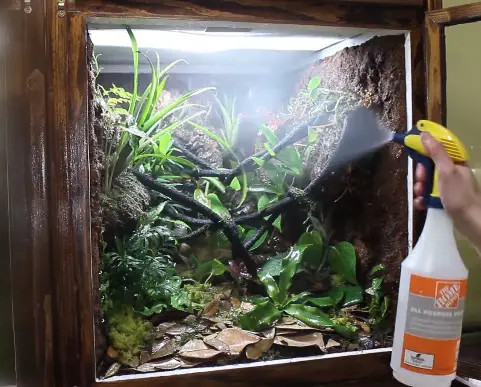
(Source: SerpaDesign YouTube)
It is best to clean your crested gecko’s cage every day. You should also mist the paper towels at night to maintain high humidity. You will need to change the paper towels at least once a week and also clean the décor.
Ensure that you change the Substrate and clean the tank at least once a month.
Conclusion
Crested gecko habitat is relatively affordable and straightforward to set up. But you should ensure you follow the proper steps to make the life of your crested geckos as comfortable as possible.
